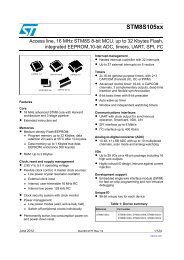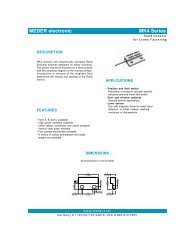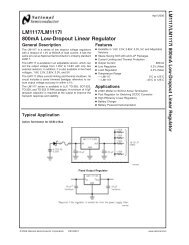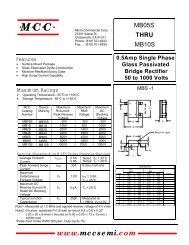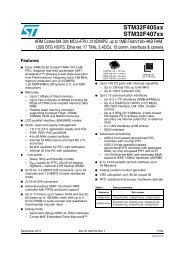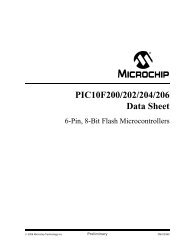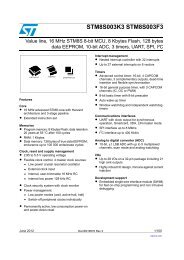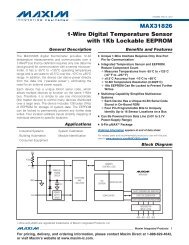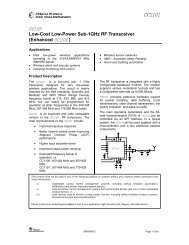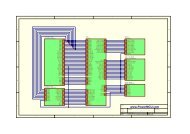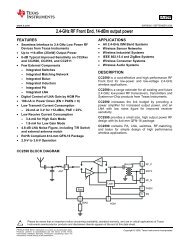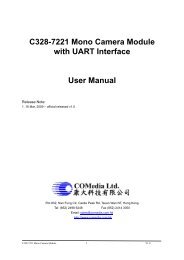High-Performance, Fully-Differential Audio Op Amp (Rev. B)
High-Performance, Fully-Differential Audio Op Amp (Rev. B)
High-Performance, Fully-Differential Audio Op Amp (Rev. B)
Create successful ePaper yourself
Turn your PDF publications into a flip-book with our unique Google optimized e-Paper software.
OPA1632<br />
SBOS286B –DECEMBER 2003–REVISED JANUARY 2010<br />
www.ti.com<br />
It is important to maintain accurate resistor matching SHUTDOWN FUNCTION<br />
on R 1 /R 2 and R 3 /R 4 to achieve good differential signal<br />
balance. Use 1% resistors for highest performance.<br />
The shutdown (enable) function of the OPA1632 is<br />
When connected for single-ended inputs (inverting<br />
referenced to the negative supply of the operational<br />
input grounded, as shown in Figure 11), the source<br />
amplifier. A valid logic low (< 0.8V above negative<br />
impedance must be low. <strong>Differential</strong> input sources<br />
supply) applied to the enable pin (pin 7) disables the<br />
must have well-balanced or low source impedance.<br />
amplifier output. Voltages applied to pin 7 that are<br />
greater than 2V above the negative supply place the<br />
Capacitors C 1 , C 2 , and C 3 should be chosen carefully amplifier output in an active state, and the device is<br />
for good distortion performance. Polystyrene, enabled. If pin 7 is left disconnected, an internal<br />
polypropylene, NPO ceramic, and mica types are pull-up resistor enables the device. Turn-on and<br />
generally excellent. Polyester and high-K ceramic turn-off times are approximately 2ms each.<br />
types such as Z5U can create distortion.<br />
Quiescent current is reduced to approximately<br />
0.85mA when the amplifier is disabled. When<br />
FULLY-DIFFERENTIAL AMPLIFIERS<br />
disabled, the output stage is not in a high-impedance<br />
<strong>Differential</strong> signal processing offers a number of state. Thus, the shutdown function cannot be used to<br />
performance advantages in high-speed analog signal create a multiplexed switching function in series with<br />
processing systems, including immunity to external multiple amplifiers.<br />
common-mode noise, suppression of even-order<br />
nonlinearities, and increased dynamic range. OUTPUT COMMON-MODE VOLTAGE<br />
<strong>Fully</strong>-differential amplifiers not only serve as the<br />
primary means of providing gain to a differential<br />
The output common-mode voltage pin sets the dc<br />
signal chain, but also provide a monolithic solution for<br />
output voltage of the OPA1632. A voltage applied to<br />
converting single-ended signals into differential<br />
the V OCM pin from a low-impedance source can be<br />
signals allowing for easy, high-performance<br />
used to directly set the output common-mode voltage.<br />
processing.<br />
For a V OCM voltage at mid-supply, make no<br />
connection to the V OCM pin.<br />
A standard configuration for the device is shown in<br />
Figure 12. The functionality of a fully differential<br />
Depending on the intended application, a decoupling<br />
amplifier can be imagined as two inverting amplifiers<br />
capacitor is recommended on the V OCM node to filter<br />
that share a common noninverting terminal (though<br />
any high-frequency noise that could couple into the<br />
the voltage is not necessarily fixed). For more<br />
signal path through the V OCM circuitry. A 0.1mF or 1mF<br />
information on the basic theory of operation for fully<br />
capacitor is generally adequate.<br />
differential amplifiers, refer to the Texas Instruments Output common-mode voltage causes additional<br />
application note SLOA054, <strong>Fully</strong> <strong>Differential</strong> current to flow in the feedback resistor network. Since<br />
<strong>Amp</strong>lifiers, available for download from the TI web this current is supplied by the output stage of the<br />
site (www.ti.com).<br />
amplifier, this creates additional power dissipation.<br />
For commonly-used feedback resistance values, this<br />
current is easily supplied by the amplifier. The<br />
additional internal power dissipation created by this<br />
+15V<br />
current may be significant in some applications and<br />
may dictate use of the MSOP PowerPAD package to<br />
effectively control self-heating.<br />
V IN+<br />
V OCM<br />
V IN<br />
Digital<br />
Output<br />
V IN<br />
V IN+<br />
V COM<br />
15V<br />
Figure 12. Typical ADC Circuit<br />
8 Copyright © 2003–2010, Texas Instruments Incorporated<br />
Product Folder Link(s): OPA1632



